Documents: Go to download!
- Owner's manual - (English)
- Getting started
- Use your TV
- Getting the most from your TV
- Useful tips
- Maintenance
- Specifications
Table of contents
User manual Television
Getting started
Features
- DTV / Analog TV / CATV You can use your remote control to select channels which are broadcast in digital format and conventional analog format. Also, cable and satellite subscribers can access their TV channels.
- Information display You can display on the TV screen the title, contents (DTV only) and other information on the current program.
- Auto scan This unit automatically scans and memorizes channels available in your area, eliminating difficult setup procedures.
- Child lock This feature allows you to block children’s access to inappropriate programs.
- Closed caption decoder Built-in closed caption decoder displays text for closed caption supported programs.
- MTS / SAP tuner Audio can be selected from the remote control.
- Auto standby If there is no input signal and no operation for 15 minutes, the unit will go into standby mode automatically.
- Sleep timer You can set the unit to go into standby mode after a specific amount of time.
- Choices for on-screen language Select your on-screen language: English, Spanish or French.
- Stereo sound function
- PLL frequency synthesized tuning Provides free and easy channel selection and lets you tune directly to any channel using the number and decimal point “•” keys on the remote control.
- Various adjustments for picture and sound Customizes picture quality suitable for your room and sets your sound preference.
- HDMI-CEC via HDMI link HDMI-CEC allows your other HDMI link Devices to be controlled by the HDMI cable connected to your TV.
- HDMI input
- HDMI-DVI input If your video device has a DVI output jack, use an HDMI-DVI conversion cable to connect the unit.
- Component video input
- AV input Audio and video input from an external device.
- USB terminal The picture (JPEG) files stored on a USB memory stick can be played back on this unit.
- Digital audio output Digital audio (Supporting Dolby Digital) sent to home theaters and other digital audio systems.
- Headphone audio output Headphone 3.5mm stereo jack for personal listening
Installing the stands
Fasten the stand to the TV with 2 screws.
- While fastening the screws, hold the stand to prevent it from falling.
- Both stands should now be securely fastened.

Note(s)
- Make sure to use a table which can support the weight of this unit and is larger than this unit.
- Make sure the table is in a stable location.
- A phillips-head screwdriver is required to fasten the stands to the TV set.
- When attaching the stand, ensure that all screws are tightly fastened. If the stand is not properly attached, it could cause the unit to fall, resulting in injuries as well as damage to the unit.
- To remove the stand from this unit, unscrew the phillips-head screws by reversing the procedure. Be careful not to drop the stand when you remove
Installing the remote control batteries
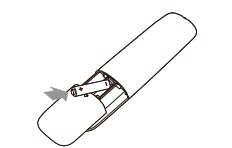
- Slide the battery cover off the back of the remote control.
- Insert the two included batteries (AAA, 1.5V). Be sure the + and – ends of the batteries line up with the markings inside the case.
- Slide the cover back into position.
Remote control
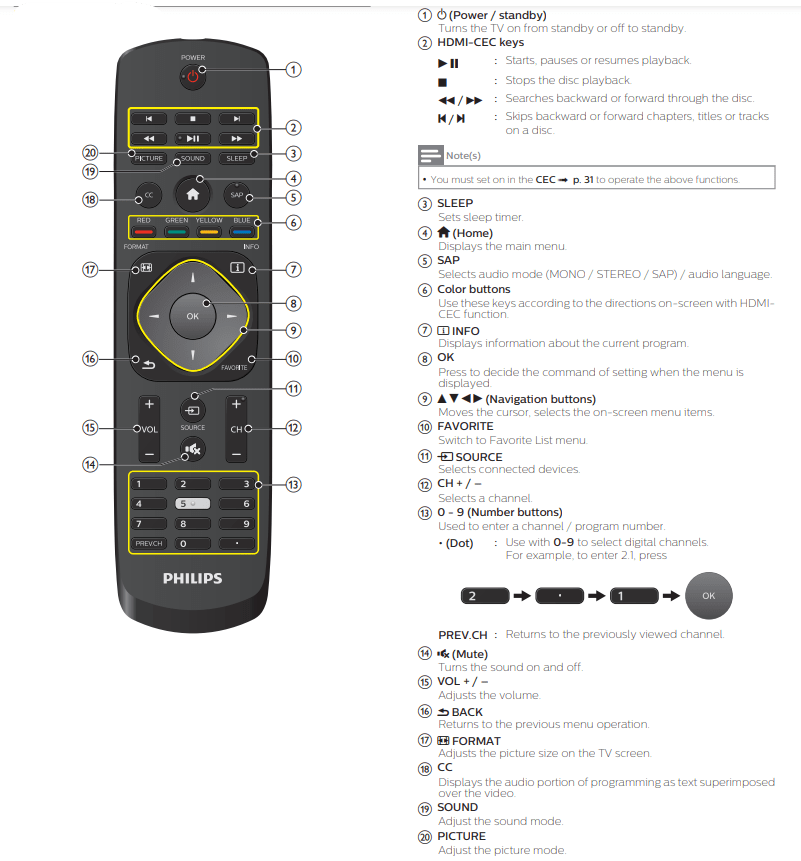
Control panel
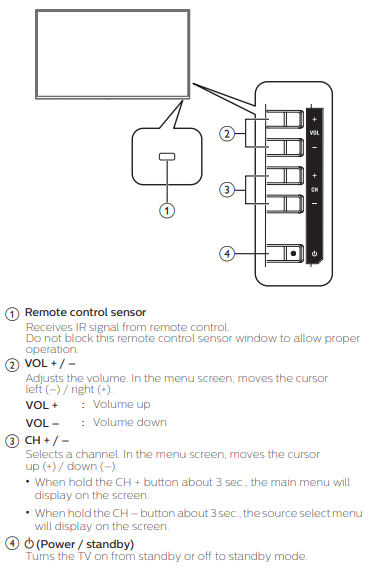
Terminals
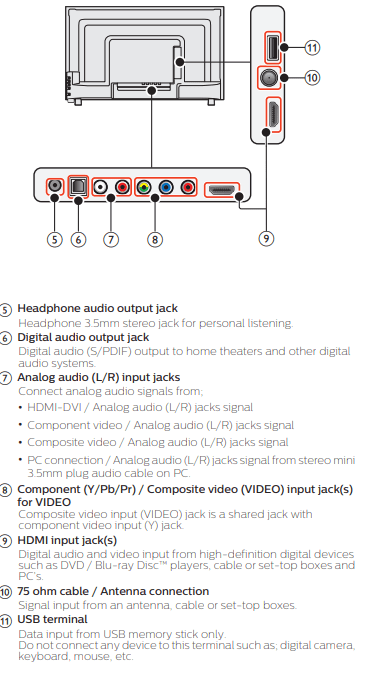
Connecting antenna or cable / satellite set-top box
- Be sure your antenna or another device is connected properly before plugging in the AC power cord.
- If connecting to an antenna through an RF cable: Any DTV programs that are broadcast in your area can be received for free through an antenna connection.

- If connecting cable / satellite set-top box using an RF cable: If the TV is connected to a cable / satellite set-top box via a coaxial connection, set the TV to channel 3/4 or the channel specified by the service provider.
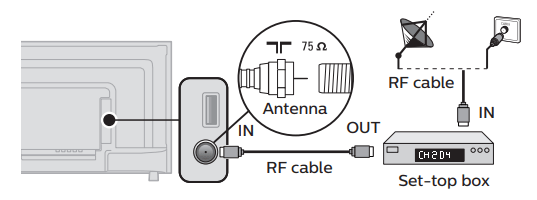
- If connecting cable / satellite set-top box using an HDMI cable: If the TV is connected to a cable / satellite set-top box via an HDMI cable, make sure you select the correct source by using
 SOURCE
SOURCE
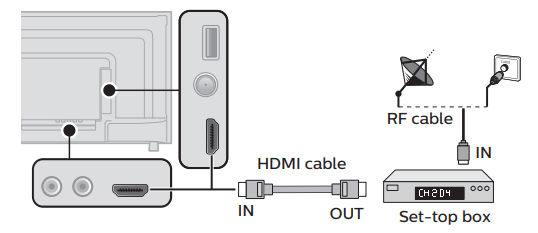
- If connecting cable / satellite set-top box using component video input: If the TV is connected to a cable / satellite set-top box via component video input, make sure you select the correct component video source by using
 SOURCE
SOURCE
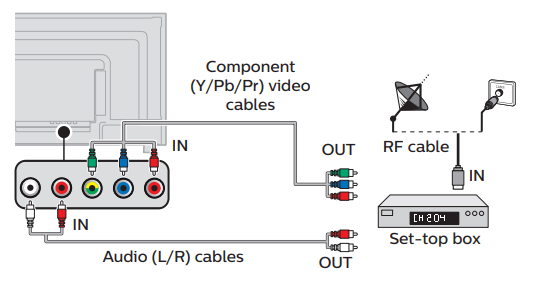
- Connecting a cable / satellite set-top box, Blu-ray Disc™ / DVD recorder via composite connectors and analog audio: Do not place your recorder too close to the screen because some recorders can be susceptible to signals from the TV
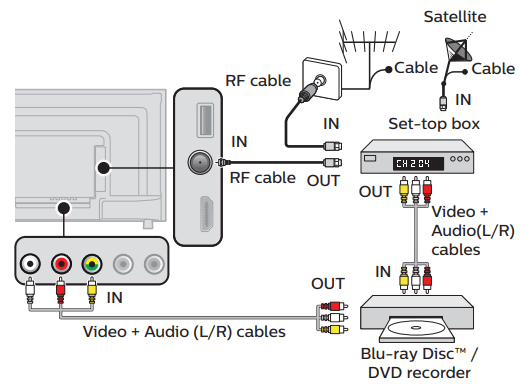
Plugging in the AC power cord
- Make sure all the necessary connections are made before the AC power cord is plugged into an AC outlet
- Caution(s)
- Connect the analog audio signal cables from the external device to the analog audio L/R input jacks.
- If you have an amplifier, connect the HDMI cable to the HDMI input via your amplifier.
- Note(s): Each time you plug in the AC power cord, no operations will be performed for several seconds. This is not a malfunction.
Selecting your connection quality
HDMI - Highest quality

- Supports high-definition digital signals and gives highest picture and sound quality. Video and audio signals are combined in one cable. You must use HDMI for full high-definition video and to enable EasyLink.
- Note(s): Philips HDMI supports HDCP (High-bandwidth Digital Contents Protection). HDCP is a form of digital rights management that protects high-definition content in Blu-ray Disc™ or DVDs
Component (Y Pb Pr) - High quality
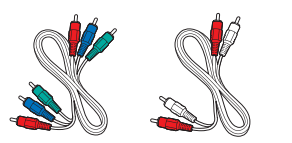
- Supports high-definition analog signals but gives lower picture quality than HDMI. Component (Y/Pb/Pr) video cables combine red / green / blue video cables with red / white audio (L/R) cables. Match the cable colors when you connect to the TV.
Composite - Basic quality
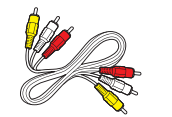
- For analog connections. Composite video / Audio analog cable usually combine a yellow video cable with red / white audio (L/R) cables. With this unit, yellow cable must be connected to Y (green) jack on the component video input jacks.
Connecting your devices
HDMI digital connection
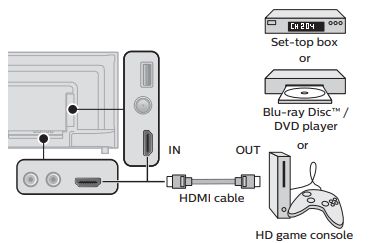
- HDMI connection offers the highest picture quality. HDMI (High-Definition Multimedia Interface) transports highdefinition digital video and multi-channel digital audio through a single cable
HDMI-DVI connection

- This unit can be connected to a device that has a DVI terminal. Use an HDMI-DVI conversion cable for this connection and it requires audio cable for analog audio signal as well.
Component analog video connection
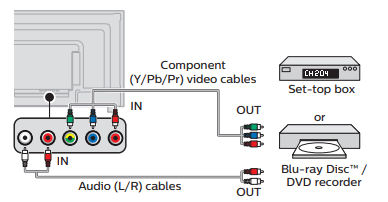
- Component analog video connection offers better picture quality for video devices connected to the unit.
- If you connect to the unit’s component video (Y/Pb/Pr) input jacks, connect analog audio cables to the analog audio (L/R) input jacks.
Composite analog video connection
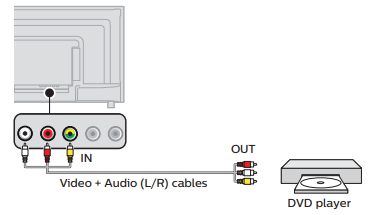
- Composite analog video connection offers standard picture quality for video devices connected to the unit.
- If you connect to the unit’s component / composite video (Y/VIDEO) input jack (green), connect audio cables to the audio (L/R) input jacks. When the audio is monaural, then only connect to the audio L input jack.
Digital audio output connection
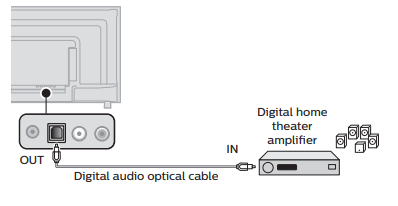
- If you connect this unit to an external digital audio device, you can enjoy multi-channel audio like 5.1ch digital broadcasting sound.
- Use a digital audio optical cable to connect the unit to external digital audio devices.
PC connection
HDMI connection
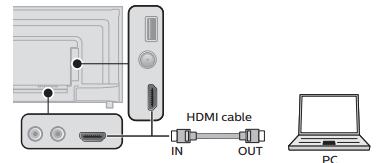
- This unit can be connected to your PC that has an HDMI terminal. Use an HDMI cable for this digital connection.
HDMI-DVI connection
- This unit can be connected to your PC that has a DVI terminal. Use an HDMI-DVI conversion cable for this video digital connection and it requires stereo mini 3.5mm plug audio cable for analog audio signal as well.
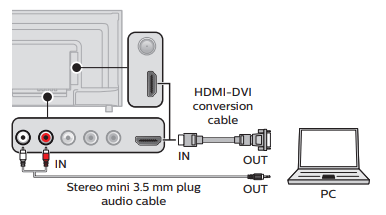
- The following PC-input video signals can be displayed:
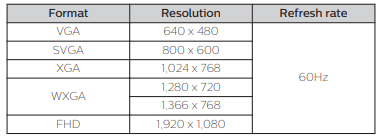
- Other formats or non-standard signals will not be displayed correctly.
USB memory stick
- This unit offers easy playback of picture (JPEG) files.
- Insert the USB memory stick into the USB terminal shown below. MULTIMEDIA

Setup wizard
This section will guide you through the unit’s Setup wizard which includes selecting a language for your On-screen menu and auto scan, which automatically scans and memorizes viewable channels.
Before you begin: Make sure the unit is connected to an antenna or cable.
- After making all the necessary connections, press
 to turn on the unit.
to turn on the unit.
- It may take a few moments to turn on the unit for the first time.
- Setup Wizard menu appears automatically after the unit is turned on.
- Use
 to select Menu Language and use
to select Menu Language and use  to select English, Spanish or French.
to select English, Spanish or French. - Use
 to select Go to next step and press OK.
to select Go to next step and press OK. - Use
 to select Time Zone and use
to select Time Zone and use  to select Pacific / Alaska / Hawaii / Atlantic / Eastern / Central / Mountain.
to select Pacific / Alaska / Hawaii / Atlantic / Eastern / Central / Mountain. - Use
 to select Daylight Saving Time and use
to select Daylight Saving Time and use  to select On / Off.
to select On / Off. - Use
 to select Time Format and use
to select Time Format and use  to select 24-hour / 12-hour.
to select 24-hour / 12-hour. - Use
 to select Go to next step and press OK.
to select Go to next step and press OK. - Use
 to select Antenna/Cable and use
to select Antenna/Cable and use  to select Antenna / Cable. – When Antenna is selected, the TV detects antenna signals. It searches for DTV and analog TV channels available in your area. – When Cable is selected, the TV detects signals supplied by cable. It searches for DTV, analog TV and cable channels available in your area.
to select Antenna / Cable. – When Antenna is selected, the TV detects antenna signals. It searches for DTV and analog TV channels available in your area. – When Cable is selected, the TV detects signals supplied by cable. It searches for DTV, analog TV and cable channels available in your area. - Use
 to select Go to next step and press OK.
to select Go to next step and press OK.
- Auto Tuning will begin
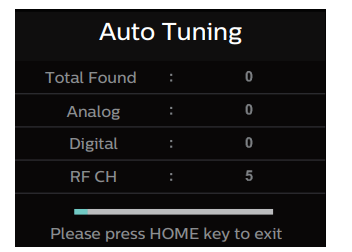
After an setup wizard is completed...
- If you want to scan the channels automatically again. Start Scan
- You can add the desired cable and analog channels not memorized by auto scan. Favorite
- If you want to change to another language. Menu Language
Use your TV
Switching on your TV and putting it in standby mode

- To turn the TV on from standby or off to standby: Press
 on the unit or the remote control
on the unit or the remote control - Note(s): Energy consumption contributes to air and water pollution. When the AC power cord is plugged in, your TV consumes energy with a very low standby power consumption.
Adjusting volume

- To decrease or increase volume
- Press VOL + / – on the TV or the remote control. VOL + : Volume up VOL – : Volume down
- To mute or unmute sound
- Press
 on the remote control to mute the sound.
on the remote control to mute the sound. - Press
 again or VOL + to recover the original sound
again or VOL + to recover the original sound
- Press
Switching channels
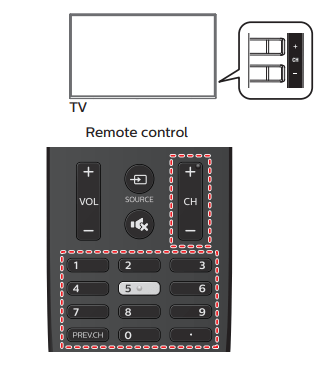
To select channels by using CH + / –
- Press CH + / – on the TV or the remote control.
To select channels by using the Number keys

For digital channels, press a number followed by a dot “•” and the corresponding sub channel number.
- When selecting digital channel 11.1 Be sure to press • before entering the subchannel number.

- When selecting cable or analog channel 11

Press PREV.CH to return to the previously viewed channel.
Watching channels from an external device
Switching each input mode can easily switch with the remote control between TV and external devices when they are connected to the unit.
1. Turn on the set-top box or the connected device.

- Press
 SOURCE and use
SOURCE and use  to select the set-top box or the connected device and wait a few seconds till the picture appears. Source Select TV Video HDMI1 HDMI2 MULTIMEDIA Move Select Back
to select the set-top box or the connected device and wait a few seconds till the picture appears. Source Select TV Video HDMI1 HDMI2 MULTIMEDIA Move Select Back 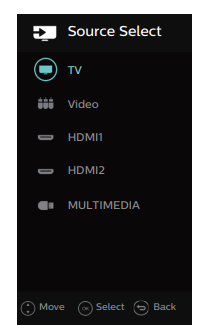
- Use the remote control of the set-top box or the connected device to select channels.
Sleep timer
- Sleep timer can set the unit to go into standby mode after an incremental period of time.

- Press SLEEP repeatedly to change the amount of time (increases the time by 5 minutes up to 240 minutes).

- Press SLEEP once to call up the display for checking the remaining time.
- To cancel sleep timer, press SLEEP Repeatedly until Off is displayed.
Switching audio mode

- Press SAP to display the currently selected language.
- Press SAP repeatedly to cycle through the available audio languages.

Note(s)
- Available languages differ depending on the broadcast.
- Other is displayed when the audio language cannot be acquired or the acquired languages are other than English, French or Spanish.

- Press SAP to display the currently selected audio mode.
- While receiving an MTS broadcast, press SAP repeatedly to cycle through the available audio channels. e.g.) When all audio modes are available

- Stereo : Outputs stereo audio
- Mono : Outputs mono audio
- SAP : Outputs a second audio program
Create a list of favorite channels
- You can create lists of your preferred TV channels so that you can find those channels easily.
- Add channels to create a favorite list, refer to Favorite
Getting the most from your TV
- This section describes the overview of the main menu displayed when you press
 .
. - The main menu consists of the function setting items below.
Displaying the main menu
1 Press  to display the main menu
to display the main menu

2 Use 
 to select the desired menu and an item, then press OK.
to select the desired menu and an item, then press OK.
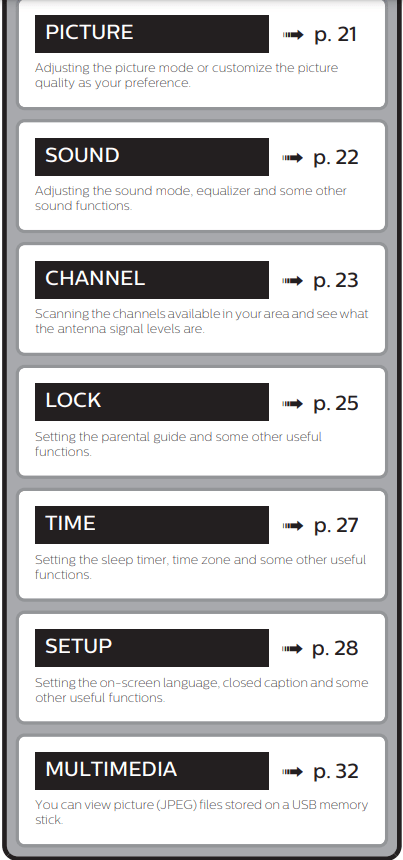
3 When the setting is completed, press  or
or  BACK to exit
BACK to exit
Useful tips
FAQ
1. My remote control does not work. What should I do?
- Check the antenna or cable connection to the main unit.
- Check the batteries on the remote control.
- Re-insert or replace the AAA batteries with their polarities (+/–) as indicated on the remote control battery area.
- Check if there is an obstacle between the infrared sensor window and the remote control.
- Test the IR signal output use IR signal check. If okay, then possible infrared sensor trouble.
- Aim the remote control directly at the infrared sensor window on the front of the unit.
- Reduce the distance to the unit.
- When there is an infrared-equipped device such as PC near this unit, it may interrupt the remote control signal on this unit. Move the infrared-equipped device away from this unit, change the angle of the device's infrared sensor or turn off the infrared communication function.
2. How come the setup wizard appears every time I turn on this unit?
- Connect the RF coaxial cable directly to this unit and run the setup wizard.
- Make sure to complete the setup wizard before the unit goes into standby mode
3. Why can I not watch some RF signal TV programs?
- Auto scan must be completed when you set up the unit for the first time or move it to a location where previously unavailable channels are broadcast.
- Make sure Start Scan has been completed.
- The selected channel may not be broadcasting.
- When Start Scan is interrupted and not completed, some channels will not be received. Make sure to complete the auto scan.
- The selected channel cannot be viewed by the Child and ratings lock setting.
- The unit requires some kind of antenna input. An indoor antenna (Digital or VHF / UHF), an external antenna (Digital or VHF / UHF) or an RF coaxial cable from your wall cable or set-top box needs to be plugged into the unit.
4. How come there is no image from the connected external devices?
- Check the antenna, cable or other input connection to the unit.
- When using the component video connection check that the green (Y), blue (Pb/Cb) and red (Pr/Cr) connectors are connected to their corresponding colored jacks on the unit.
5. When I enter a channel number, why does it change automatically?
- Many digital channels have alternate channel numbers. The unit changes the numbers automatically to the ones signifying the broadcasting station's channel number. These basic numbers used for the previous analog broadcasts. (e.g., input digital ch# 30 automatically changes to digital ch# 8.1)
6. Why are captions not displayed entirely? Or why are captions delayed behind the dialog?
- Closed captions that are delayed a few seconds behind the actual dialog are common for live broadcasts. Most captioning production companies can display a dialog to maximum of 220 words per minute. If a dialog exceeds that rate, selective editing is used to insure that the closed captions remain up-to date with the current TV screen dialog.
7. How can I set the clock?
- Switch to TIME menu, you can set the clock in Clock selection.
8. My PIN code no longer works, how can I change the child lock setting?
- If the PIN code no longer works, you can enter the “071 1” universal password to enter the LOCK menu, then change the lock password. Refer to Child and ratings lock
Troubleshooting tips
If the unit does not perform properly when operated as instructed in this User manual
Please check the following Troubleshooting tips and all connections once before calling for service.
1. Power - No power
- Make sure the AC power cord is plugged in.
- Make sure that the AC outlet supplies the proper voltage, plug another electrical appliance into the AC outlet to ensure that the AC outlet operates normally.
- If a power failure occurs, unplug the AC power cord for 1 minute to allow the unit to reset itself.
2. Remote
- Control keys do not work.
- Do NOT press more than one key at the same time.
- Ensure that no keys on the remote control are depressed and move freely.
- Universal remote control does not work properly.
- Refer to the User manual of the universal remote control for the Philips code.
3. Picture
- Power is on but no screen image.
- Check whether the connection for the antenna, cable or set-top box is connected correctly.
- Check whether all the cables to the unit are connected to the correct output jack on your separate device like Blu-ray Disc™ / DVD recorder.
- Make sure that the selected input mode is connected to the working input jack.
- Check if your computer is NOT in sleep mode when the input mode on this unit is in PC mode. Tap any key on the computer keyboard to wake it up.
- No color
- View other TV channels. The problem might be limited to the broadcasting station.
- Adjust Color in PICTURE settings.
- Picture poor
- Adjust Brightness and Contrast in PICTURE settings.
- For the best picture quality, watch “High Definition” wide screen programs. If the HD content is not available, watch “Standard Definition” programs instead.
- You see pixelation on the screen.
- When the capabilities of the unit exceed the capabilities of the digital broadcasting, the signal will be increased to match the capabilities of the display on the unit. This may cause pixelation, noise or trash.
- Unusual picture appears and the TV does not operate.
- Make sure to press
 (Power / standby) button on the control panel of this unit to change the live mode. (
(Power / standby) button on the control panel of this unit to change the live mode. ( (Power / standby) button on the remote controller does not solve this problem.)
(Power / standby) button on the remote controller does not solve this problem.) - Unplug the AC power cord, then wait for one minute, and then plug it in again
- Make sure to press
4. Sound
- No sound, distorted sound or incorrect audio sound is heard when using the HDMI-DVI connections.
- Make sure that the analog audio signals from the HDMI-DVI device are connected to the analog audio (L/R) input jacks. Refer to PC connection
- When using component analog video, composite analog video or HDMIDVI video make sure that the analog audio (L/R) connectors are mounted into the audio (L/R) input jacks.
- Sound intermittent or no sound.
- Check if the audio cable is connected into the unit correctly.
- You switch to a different input and the volume changes.
- This unit will memorize the volume level from the last time you adjusted it.
- If the volume of the sound from another device is higher or lower, then the loudness will change.
- Make sure AVL is set to On.
5. Picture & Sound
- No picture or sound
- Check if the power is on.
- Check whether all the cables to the unit are connected to the correct output jack of your device like Blu-ray Disc™ / DVD recorder.
- View other TV channels. The problem might be limited to the broadcasting station or weak signal strength, if DTV channel check signal strength.
- Unplug the AC power cord and wait for about 1 minute, then plug the AC power cord and turn on the unit again.
- Check whether the connection of the antenna or cable or set-top box is connected correctly.
- Make sure that the selected input mode is connected to the working input jack.
- Check if your computer is NOT in sleep mode when the input mode of this unit is in HDMI mode. Tap any key on the keyboard to wake up your computer.
- Make sure that the sound is not muted. Press
 so that the volume bar and current volume level will appear on the TV screen.
so that the volume bar and current volume level will appear on the TV screen.
- You see a distorted picture or hear an unusual sound. (Analog TV - NTSC signal)
- You may be getting interference from electrical appliances, automobiles, motorcycles or fluorescent lights.
- Try moving the unit to another location to see if this is the cause of the problem.
- Ghosts, lines or streaks in picture. (Analog TV- NTSC signal)
- Electrical interference from nearby appliances may affect picture quality.
- View other TV channels. The problem might be limited to the broadcasting station or weak signal strength, if DTV channel check signal strength.
- Picture poor, sound intermittent or no sound
- View other TV channels. The problem might be limited to the broadcasting station or weak signal strength, if DTV channel check signal strength
6. Screen
- You switch to a different input and the screen size changes.
- This unit will memorize the viewing mode from the last time you used those particular input modes.
- The display image does not cover the entire screen.
- If you are watching TV or using the composite video, component video or HDMI with 480i input, press
 FORMAT repeatedly to switch to various screen modes.
FORMAT repeatedly to switch to various screen modes.
- If you are watching TV or using the composite video, component video or HDMI with 480i input, press
- Different color marks on the TV screen
- View other TV channels. The problem might be limited to the broadcasting station, missing data or pixelation due to weak signal strength.
7. Closed captions
- Closed captions are displayed as a white box. No closed captions are displayed in the closed captions-supported program.
- Interference from buildings or weather conditions may cause captioning to be incomplete if watching Analog TV signals.
- Broadcasting station may shorten the program to insert advertisements.
- The closed captions decoder cannot read the information of a shortened program.
- Black box is displayed on the TV screen.
- The text mode is selected. For closed captions, select CC 1, CC 2, CC 3 or CC 4.
- If connected to a Blu-ray Disc™ / DVD device then closed captions are part of its video signal and is only controlled through this device's menu or remote control. Remove the TV closed captions mode.
Note(s)
- The LCD screen is manufactured to provide many years of useful life. Occasionally a few non active pixels may appear as a fixed point of blue, green or red. This is not to be considered a defect in the LCD screen.
- Some functions are not available in specific modes, but this is not a malfunction. Read the description in this User manual for more details on correct operations of this unit.
Maintenance
Cleaning
- Clean the front panel and other exterior surfaces of the unit with a soft microfiber cloth or lens brush. Before cleaning the panel, disconnect the AC power cord.
- Never use a solvent or alcohol. Do not spray insecticide liquid near the unit. Such chemicals may cause damage and discoloration to the exposed surfaces.
- Do not spray any liquids on the screen or other exterior surfaces of this unit. If liquids enter the unit, they could cause shorts, electric shocks or fire damage.
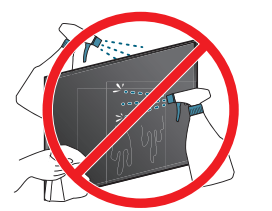
Servicing
- Should your unit become inoperative, Do not try to correct the problem yourself. There are no user serviceable parts inside. Call our toll free customer support line found on the cover of this User manual to locate an authorized service center.
IR signal check
- If the remote control is not working properly, you can use a digital or cell phone camera to see if it is sending out an infrared signal.
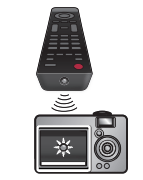
- e.g.) With a digital camera: Point the digital camera towards the remote control infrared diode at the front of the remote control. Press and hold any key on the remote control and look at the camera display. If an infrared pulsating light appears on the display, the remote control is sending out an IR signal.
- Note: Some cameras may have an IR filter or dual camera cell phones may have an IR filter in one of the camera's and both will not display the IR signal.
Specifications
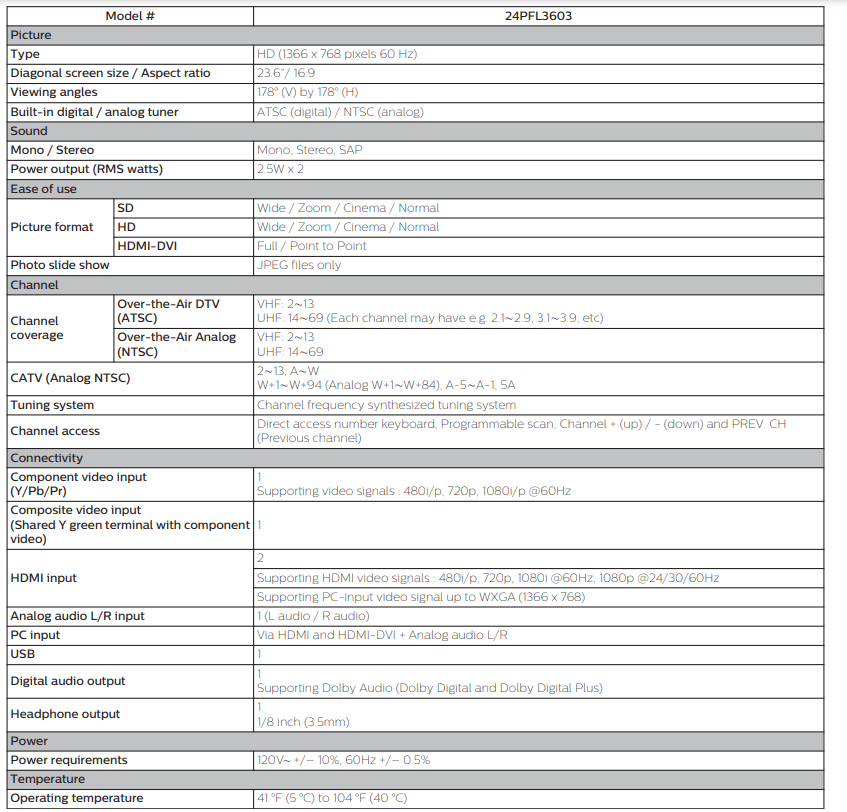
See other models: HD9621/26 HD9641/26 HD9630/98 HD9622/26 HD9621/06
